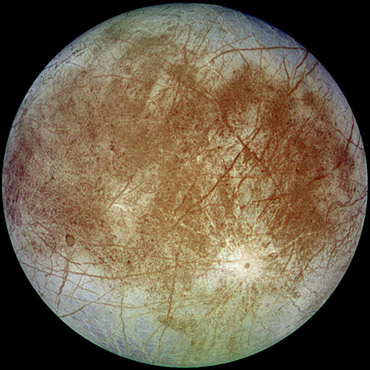Exploring the deep ocean is like exploring another world — it’s a realm unlike anything on dry land. In recent years, though, marine scientists have been taking the “other-world” concept to extremes — they’re working with astronomers and planetary scientists to study oceans on other planets and moons.
 Europa, as seen by the Galileo spacecraft. Credit: NASA
Europa, as seen by the Galileo spacecraft. Credit: NASAThe best example is on Europa, one of the largest moons of Jupiter. Its icy crust appears to hide a global ocean — one that holds more liquid water than all of Earth’s oceans combined. That makes Europa a possible habitat for life.
A gravitational tug-of-war between Jupiter and some of its other large moons heats Europa’s interior. That melts some of the ice, creating an ocean that appears to be many miles deep. It may also create fountains of mineral-rich hot water at the bottom of the ocean. Similar structures in Earth’s oceans are surrounded by abundant life. On Europa, they may provide all the basic ingredients for life — water, energy, and nutrients.
The ocean itself may generate more energy by sloshing around beneath the ice cap as it, too, is tugged by the gravity of Jupiter and the other moons.
And recent research says the ice cap, which is probably a few miles thick, may contain pockets of liquid water that are as big as the Great Lakes here on Earth.
Scientists from many disciplines are already studying ways to get a closer look at Europa’s ocean. Eventually, they may build a submarine to burrow through the ice and swim through the ocean — providing a close-up look at a truly alien environment.

